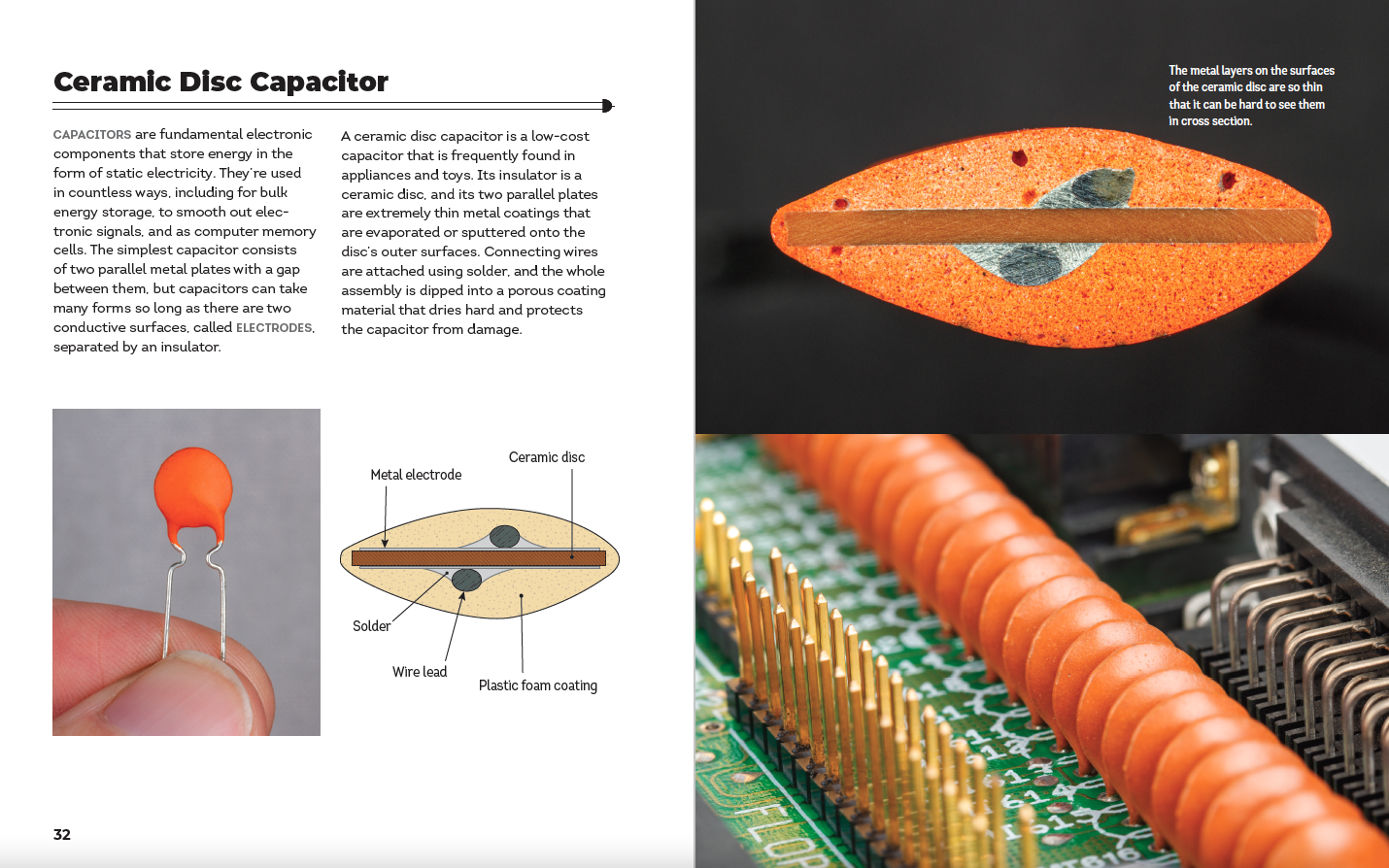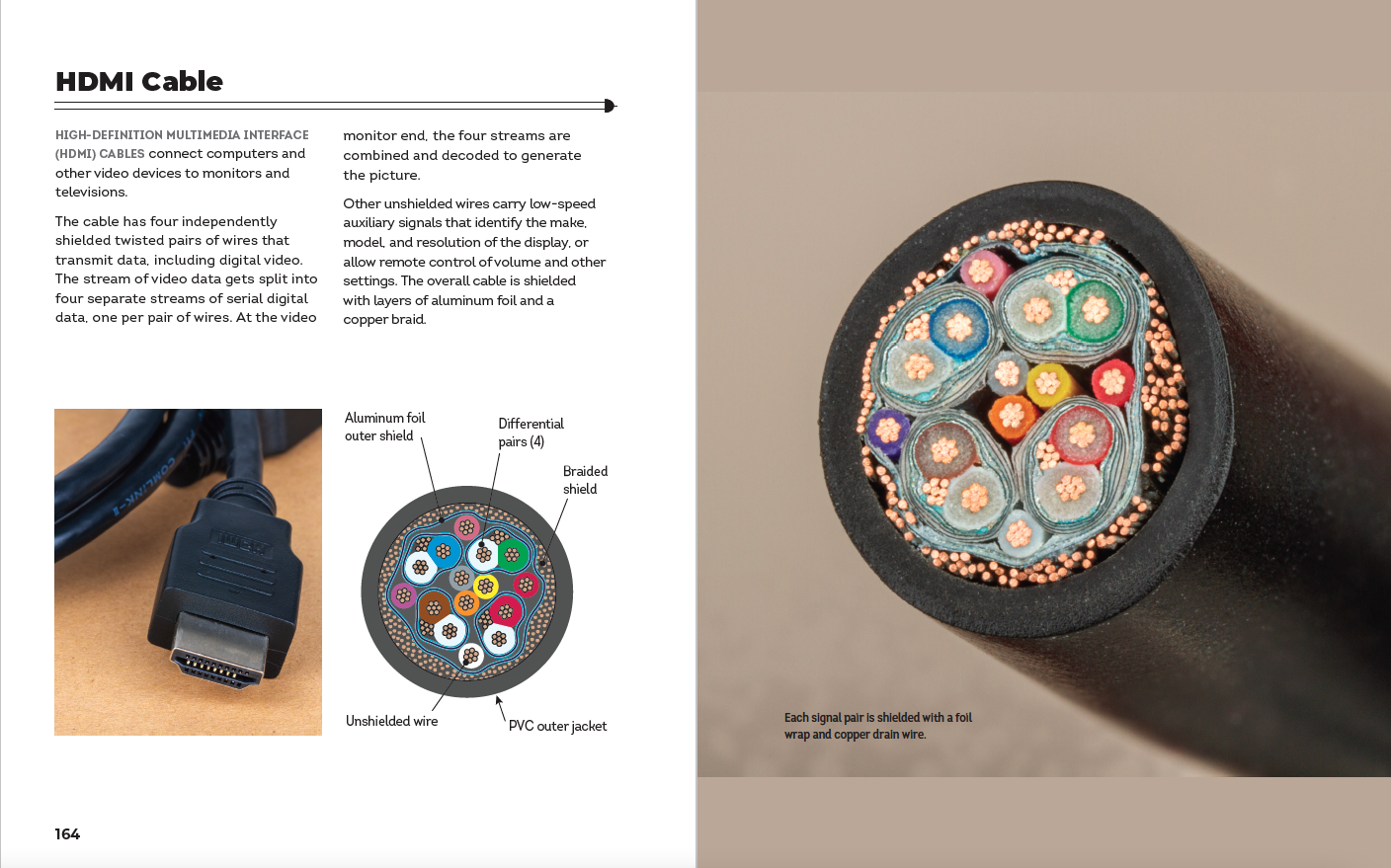There’s a profound beauty in well-crafted electronics.
Somehow, the laws of physics conspired with the evolution of human consciousness such that sound engineering solutions are also aesthetically appealing: from the ideal solder fillet, to the neat geometric arrangements of components on a circuit board, to the billowing clouds of standard cells laid down by the latest IC place-and-route tools, aesthetics both inspire and emerge from the construction of practical, everyday electronics.
Eric Schlaepfer (@TubeTimeUS) and Windell Oskay (co-founder of Evil Mad Scientist)’s latest book, Open Circuits, is a celebration of the electronic aesthetic, by literally opening circuits with mechanical cross-sections, accompanied by pithy explanations and illustrations. Their masterfully executed cross-sectioning process and meticulous photography blur the line between engineering and art, reminding us that any engineering task executed with soul and care results in something that can inspire feelings of awe (“wow!”) and reflection (“huh.”): that is art.
The pages of Open Circuits contain ample inspiration for both novices and grizzled veterans alike. Having been in electronics for four decades, I sometimes worry I’m becoming numb and cynical as I watch the world’s landfills brim with cheap electronics, built without care and purchased (and disposed of) with even less thought. However, as I thumb through the pages of Open Circuits, that excitement, that awe which I felt as a youth when I traced my fingers along the outlines of the resistors and capacitors of my first computer returns to me. Schlaepfer and Oskay render even the most mundane artifacts, such as the ceramic disc capacitor, in splendid detail – and in ways I’ve never seen before. Prior to now, I had no intuition for the dimensions of an actual capacitor’s dielectric material. I also didn’t realize that every thick film resistor bears the marks of lasers that trim it to its final value. Or just seeing the cross-section of a coaxial cable, as joined through a connector – all of a sudden, the telegrapher’s equations and the time domain reflectometry graphs take on a new and very tangible meaning to me. Ah, I think, so that’s the bump in the TDR graph at the connector interface!
Also breathtaking is the sheer scope of components addressed by Schlaepfer and Oskay. Nothing is too retro, nothing is too modern, nothing is too delicate: if you’ve ever wanted to see a vacuum tube cut in half, they managed to somehow slice straight through it without shattering the thin glass envelope; likewise, if you ever wondered what your smartphone motherboard might look like, they’ve gone and sliced clear through that as well.
One of my favorite tricks of the authors is when they slice through optoelectronic devices: somehow, they manage to cut through multiple LEDs and leave them in an operable state, leading to stunning images such as a 7-segment LED still displaying the number “5” yet revealed in cross-section. I really appreciate the effort that went into mounting that part onto a beautifully fabricated and polished (perhaps varnished?) copper-clad circuit board, so that not only are you treated to the spectacle of the still-functional cross sectioned device, you have the reflection of the device rippling off of a handsomely brushed copper surface. Like I said: any engineering executed with soul and care is also art.
In a true class act, Schlaepfer and Oskay conclude the book with an “Afterward” that shares the secrets of their cross-sectioning and photography techniques. Adhering to the principle of openness, this meta-chapter breaks down the fourth wall and gives you a peek into their atelier, showing you the tools and techniques used to generate the images within the book. Such sharing of hard-earned knowledge is a hallmark of true masters; while lesser authors would withold such trade secrets, fearing others may rise to compete with them, Schlaepfer and Oskay gain an even deeper respect from their fans by disclosing the effort and craft that went into creating the book. Sharing also plants the seeds for a broader community of circuit-openers, preserving the knowledge and techniques for new generations of electronics aficionados.
Even if you’re not a “hardware person”, or even if you’re “not into tech”, the images in Open Circuits are so captivating that they may just tempt you to learn a bit more about it. Or, perhaps more importantly, a wayward young mind may be influenced to realize that hardware isn’t scary: it’s okay to peel back the covers and discover that the fruits of engineering are not merely functional, but also deeply aesthetic as well. I know that a younger version of me would have carried a copy of this book everywhere I went, poring over its pages at every chance.
While I was only able to review an early access electronic copy of their book, I am excited to get the full-color, hard-cover edition of the book. Having published a couple books with No Starch Press myself, I know the passion with which its founder, Bill Pollock, conducts his trade. He does not scrimp on materials: for The Hardware Hacker, he sprung on silver ink for the endsheets and clear UV spot inks for the cover – extra costs that came out of his bottom line, but made the hardcover edition look and feel great. So, I’m excited to see these wonderful images rendered faithfully onto the pages of a coffee-table companion book that I will be proud to showcase for years to come.
If you’re also turned on to Open Circuits, pre-order it on No Starch Press’ website, with the discount code “BUNNIESTUDIOS25”, to receive 25% off (no affiliate code or trackback in that link – 100% goes to No Starch and the authors). The code expires Tuesday, October 4. Pre-orders will also receive exclusive phone and desktop wallpaper images that are not in the book!


I just noticed that the coupon code that No Starch gave me isn’t working yet. I’ve got an email in with their team to try and figure this out. Sorry about that!
It’s working now!
Link fails with PHP errors now. Did you overwhelm their site with orders? Will try again later.
Yah, Bill Pollock tweeted that the site is having some troubles. Hopefully it’ll be back up soon…!
I’ve been meaning to order this for a little while! In related news, it seems like the code applies to the cart total rather than just Open Circuits? I’m not sure that’s intended behavior…
Looks so fun, and fruitful picture on the book…
The author of this review is deeply impressed with the book Open Circuits, which is a celebration of the beauty of well-crafted electronics. The book features stunning mechanical cross-sections of electronic components that blur the line between engineering and art, accompanied by pithy explanations and illustrations. The author notes that the book is not only a great resource for novices and experienced professionals alike, but it may also inspire a wayward young mind to explore the beauty and wonder of electronics. The author also praises the openness and transparency of the book’s authors, who disclose the techniques used to create the book’s images, thereby encouraging the growth of a community of circuit-openers. Overall, the author enthusiastically recommends Open Circuits to anyone with an interest in electronics or aesthetics.
I’ve perused a ton of terrible books. I used to survey books professionally, and when you’re a commentator you read lots of horrible books.